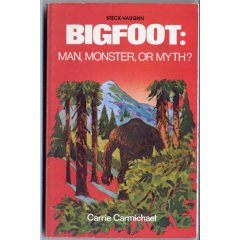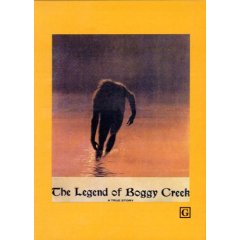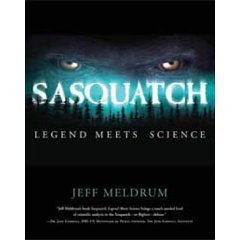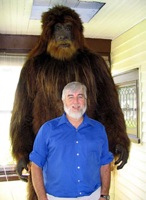Bigfoot in the Classroom
Posted by: Loren Coleman on February 20th, 2008

Today, Wednesday, February 20th, I journey north to give a 1:10 pm to 2:00 pm lecture in a classroom at the DP Corbett building at the University of Maine at Orono. This event serves as a contemporary example of how cryptozoology and Bigfoot studies are being used in colleges, universities, and, yes, in secondary and elementary settings.
Do you think this college class is being given in the anthropology or zoology department? Actually, neither.
The course involving the subject of 50 years of my passionate research interest is English 101, an introductory composition course required of all first year UMaine students.
Instructors Nick Mohlmann and Michelle Allen have designed this class so students will become involved in critical thinking. The students are required to read two books that present different view points on an issue. For their classes they are using my book Bigfoot! The True Story of Apes in America, Jeff Meldrum’s Sasquatch: Legend Meets Science and Nick Redfern’s Three Men Seeking Monsters.
Mohlmann told me: “The students are reading about Bigfoot and writing papers on Ray Wallace, the Patterson-Gimlin film, the depiction of a cryptohominid in The Legend of Boggy Creek, and whether they find the biological or paranormal explanation of Bigfoot more plausible. Dr. Pat Burnes who runs the composition program here fondly remembered a lecture you gave here at UMaine some years back when grad students were teaching a similar pairing of books. ”

That’s when Mohlmann, hearing he had a live cryptozoologist and author only a few hours away, contacted me and arranged my lecture there today.
This week, the students in the class are “working on papers dealing with the Patterson-Gimlin film. Students will be examining the film and reading yours and Dr. Meldrum’s take on the film as well as some other articles to construct arguments as to whether the film could have been hoaxed or if a hoax seems unlikely,” Mohlmann writes.

Mohlmann continues: “I’ve been interested in cryptozoology since I was in kindergarten and remember a book I would continually check out of the school library called Bigfoot: Man, Monster, or Myth.”
All in all, this university English course serves as another great example of how cryptozoology can be and is being employed in classrooms around the country. Nick Mohlmann’s casual observation about his kindergarten days illustrates how it all can be begin, in elementary school libraries.
And speaking of libraries….
For another lecture forthcoming, I’ll be delivering the “Brown Bag Lecture” at noontime, at the Portland Public Library in downtown Portland, Maine, on March 5, 2008. I will be talking about The Field Guide to Bigfoot and Other Mystery Primates (NY: Anomalist Books, 2006) and Cryptozoology A to Z: The Encyclopedia of Loch Monsters, Sasquatch, Chupacabras, and Other Authentic Mysteries of Nature (NY: Simon and Schuster, 1999).

About Loren Coleman
Loren Coleman is one of the world’s leading cryptozoologists, some say “the” leading living cryptozoologist. Certainly, he is acknowledged as the current living American researcher and writer who has most popularized cryptozoology in the late 20th and early 21st centuries.
Starting his fieldwork and investigations in 1960, after traveling and trekking extensively in pursuit of cryptozoological mysteries, Coleman began writing to share his experiences in 1969. An honorary member of Ivan T. Sanderson’s Society for the Investigation of the Unexplained in the 1970s, Coleman has been bestowed with similar honorary memberships of the North Idaho College Cryptozoology Club in 1983, and in subsequent years, that of the British Columbia Scientific Cryptozoology Club, CryptoSafari International, and other international organizations. He was also a Life Member and Benefactor of the International Society of Cryptozoology (now-defunct).
Loren Coleman’s daily blog, as a member of the Cryptomundo Team, served as an ongoing avenue of communication for the ever-growing body of cryptozoo news from 2005 through 2013. He returned as an infrequent contributor beginning Halloween week of 2015.
Coleman is the founder in 2003, and current director of the International Cryptozoology Museum in Portland, Maine.










What a fun change of pace from reading/analyzing “Occurrence At Owl Creek Bridge” or “Shaving,” which are so often among the requisite works in first year comp courses. And, who knows, this might make crypto-converts out of a few students. Good luck.
Hey, Loren, wow, your really are giving a lot of lectures about Bigfoot & Cryptozoology.
I tip my hat to instructors Nick Mohlmann and Michelle Allen.
Sounds like a great course. I’d be very interested to see what some of those students wrote concerning topics like the PG film. I would especially like to see what is written by students who are quite new to cryptozoology because I’ve found that those who are just seeing these things for the first time often have fresh perspectives and viewpoints to offer. To hear their ideas, ones that aren’t the typical fare thrown back and forth between those of us well acquainted with this stuff is fascinating to me.
Way to go Loren! I wish I could see your talk. Having worked in Libraries for over 18yrs of my professional life I can think of no more an interesting topic as Cryptozoology to get students interested in both English and Anthropology.
I’ve long believed that in any field, an oblique approach is not only good but, from time to time, like, you know, pretty much constantly, needed.
Zen mind, beginner’s mind, and all that.
Too many scientists seem too stuck in their belief systems, and too afraid of critical thinking that chips away at those.
Kudos to all involved! That all first-year students have to do this simply increases the number of potential beginner’s minds in the mix. That can only help.
(I’d love to see the argument that the paranormal explanation of Bigfoot is the more plausible. Maybe silvereagle could proctor that one.)
Great to hear about the interest in Loren lecturing at college–how about a short podcast on the site as a taster to get other colleges and schools interested?
if my teachers had offered such great assignments to read in class?
i wouldn’t have had to hide all the cool crypto books i was reading inside the oversized textbooks featuring “the classics.”
don’t get me wrong. i’m glad i read shakespeare and chaucer, too, but… did they ever hold a candle to the latest, greatest bigfoot tomes?
nawwww…. 😉
I think this is good for cryptozoology, it might spark interest in some young minds to look into it.
I do think it would be better in a logic 101 class, but it doesn’t really matter, as long as the kids are exposed to it and required to think about it.
Does anyone else see the glaring contradiction in the following sentences?
“…students will become involved in critical thinking. The students are required to read two books that present different view points on an issue. For their classes they are using my book Bigfoot! The True Story of Apes in America, Jeff Meldrum’s Sasquatch: Legend Meets Science and Nick Redfern’s Three Men Seeking Monsters.”
Let’s see: students are learning critical thinking by reading three different points of view on a topic. I’m sure that Coleman, Redfern, and Meldrum differ on some details, but all three are very much in the “pro-Bigfoot” camp. This is what passes for diversity of points of view?
If students are being asked to think critically and examine different points of view, it seems very odd that not a single skeptical article or book is among them.
Emotional skepticism is revealed, once again, in Ben’s rapid response above, where he writes without re-reading the blog, it would seem.
Besides the fact that skepticism is certainly in evidence in my book and Jeff’s on many points along the Bigfoot research path, including some very different points of view we have about the Wallace evidence, Ben completely ignores that the other side was mentioned by the instructor.
As the course’s instructor mentioned, the students are required to read “other articles to construct arguments as to whether the film could have been hoaxed or if a hoax seems unlikely.”
LOL. Those “other articles,” actually, are ones from The Skeptical Inquirer, of which Ben Radford happens to be the managing editor.
WOW! CALL THE MARINES!
Or at least check your Armageddon references and see whether we’re at End of Days.
I AGREE WITH BEN RADFORD ON SOMETHING!
Personally, most sasquatch books don’t interest me; they take too much of a monster/paranormal/Weird Occurrences slant, rather than just examining the evidence for what may be an unlisted primate. (I’d prefer to just read sighting reports. That’s the evidence, right there.) There are a number of exceptions, however, of which Loren’s and Jeff’s are two.
But I was sort of expecting more contrast here. Don’t know a thing about Redfern’s book. But you do need the debunker side of the question as well as the proponent side.
On reading Loren’s last post, I retract mine.
A leetle bit.
I think it could have been a little plainer that the Nationa…sorry, the Skeptical Enquirer was involved, because even a skeptic (let’s not give that word a bad name, now) like me missed that on the first couple reads. “Other articles” soft-pedals it a bit too much, methinks. Say what they are. Without, of course, labeling them negatively. Equal time in debates, right, Hillary? Obama? Hey, play nice…!
Jeez, skeptics, hold your fire. This blog was written before I went up to lecture in the class, and before I talked in person to the students and instructors. Please re-read it with that in mind.
What I did find was all points of view were well represented and encouraged.
There were debunkers in the class, and the instructors (in person) elaborated on the “other articles” that they emailed me about, which are being used to support the “P-G film is a hoax” POV.
It’s a class on writing, for Freshman, not on zoology or anthropology. The contrast is there, folks.
I’m pleased that the curriculum will include a diverse sampling of works by myself, David Daegling, Mike Dennett, Matt Crowley, and others. I must have read Loren’s post too quickly, because I didn’t see them mentioned. I only saw works by Coleman, Meldrum, and Redfern mentioned. Perhaps Loren or the instructors could specify what those other sources are.
I must have also been wrong about the purpose of the class, apparently it is not “critical thinking,” as stated in the original post, but simply “writing.” That’s a different story then; if the purpose is just a writing exercise, that’s one thing. If the purpose is critical thinking, that’s quite another.
I too was initially concerned that the class seemed to present “critical thinking” erroneously by contrasting only the “Great American Ape” legend presented as fact with a paranormal “explanation” for bigfoot. It is good to know that the educators were more responsible than initially presented.
By the way, I confess I owe the topic of cryptozoology my thanks for a life long habit of reading. As a kid, I enjoyed picture books and can still vividly recall one particular book, a Frank Buck “bring’em back alive” illustrated book, that had gorgeous paintings of exotic animals and birds. But I never read the books; I just looked at the pictures. (I did, however, always read the first and last pages of my dad’s Ian Flemings).
Then, one day, I found Frank Edwards’ STRANGER THAN SCIENCE and my life changed. I READ the book, over and over. It was a collection of Edwards’ columns, dealing with everything from the Loch Ness Monster to people who disappeared in plain sight. WOW! (Later I would realize that much of Edwards’ stuff consisted of “twice told tales” and what we would now call “urban legends”.) I went to the library to find other similar books, and would read and read and read. I especially enjoyed Ivan Sanderson and his ABOMINABLE SNOWMEN: LEGEND COME TO LIFE was the first hardcover book I ever bought.
And I have been reading ever since. Science, philosophy, history, non-fiction and so on. (Even the works of skeptics. It’s not painful folks. Try it.)
So, yes. I owe cryptozoology a debt. And I see how it could be used beneficently as a tool in the classroom today.